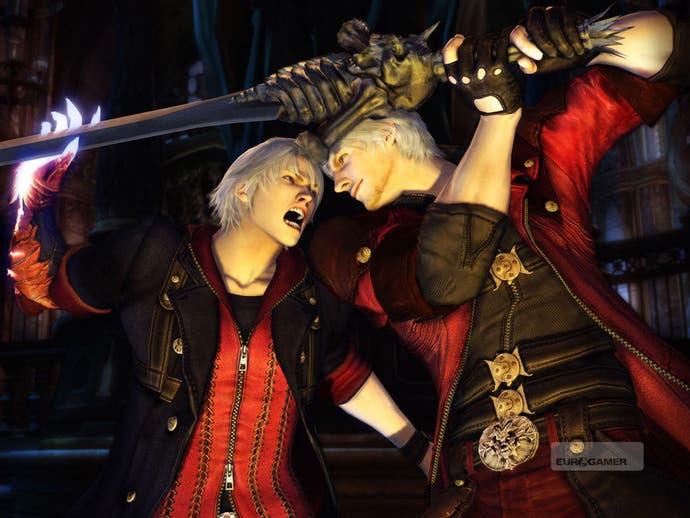Retrospective: Devil May Cry 4
The lost boys.
While Bayonetta is also well known for expressing herself with her body, Dante beat her to the punch as a protagonist who flaunts his sexuality, especially unusual for male characters. Not aimed at anyone in particular, he just likes to make love to the camera. Upon getting a new weapon, he recites a soliloquy about his dick: "First I whip it out, then I thrust it, with great force. Every angle, it penetrates. Until, with great strength, I ram it in. In the end, we're all satisfied."
Despite this blunt innuendo, the game is surprisingly chaste with relationships and never gets past hand-holding. It treats sex like a child who doesn't fully understand what it is, but still likes to snicker about it.
Bayonetta adhered to the mantra of "bigger, badder, and more badass" taking not only the bombastic sexuality up a notch, but adding a dizzying array of weapons and moves at your disposal as well. This made it easy to feel overwhelmed and instead rely on the same few combos just as a tourist would only learn to say "Excuse me" and "Which way to the bathroom?" Even after beating Bayonetta on its hardest setting I never got the impression that I'd become fluent in her unique brand of combat.
DMC4 took the opposite approach and chose to scale its arsenal back considerably since its predecessor. Instead of dumbing things down, it makes up for it with quality over quantity. Primary player character Nero's sword, the red queen, comes equipped with a motorcycle engine (yes, really) which, if revved at just the right moment during a swing, glows bright red and deals extra fire damage for its next attack. It makes every slice a timing-based mini-game which makes Gears of War's similar reload mechanic feel lethargic in comparison.

More innovative was Nero's "devil bringer," a glowing blue spectral claw that can be used as a lasso (sound familiar, Bulletstorm?). Being able to yank enemies towards you cuts down pesky walking time and drastically increases momentum in a series already known for its lightning fast action. Having such immediate access to the entire playing field was a masterstroke and it's a wonder why this hasn't caught on to other action games.
Comparatively, Bayonetta's major addition to the genre was "witch time", a period of slow motion triggered by successfully dodging at the right moment. It was a great mechanic, but was bewilderingly disabled from its unlockable harder difficulties. Crafting a harder challenge is admirable, but omitting the game's most notable feature took away much of what made it special.
Where Bayonetta lost its identity upon repeated visits, DMC4 reclaimed it. Perhaps the game's most criticized aspect was that a majority of its second half was a retread of the first. The primary difference was you played as Dante and the levels were structured differently, but environments, enemies and bosses were largely the same. Adding insult to injury, on the initially available difficulty settings Dante is grossly overpowered making the second half feel anticlimactic and half-assed. It's only upon a second playthrough on harder difficulty settings that these chapters come into their own.

Here, Dante's stages are significantly more challenging and it becomes apparent that you need to play vastly differently with him. Without the aid of the devil bringer, you must master the minutia of his move set to develop new strategies. It becomes clear that the first time around was little more than a tutorial to Dante's quickly expanding arsenal. Upon replaying these stages on harder settings, utilizing all his unlocked weapons becomes necessary. Once you realise this it no longer feels like lazy recycling, but instead makes you appreciate how well designed the enemies are to be balanced against two such different fighters.
DMC4 may not have been the bold step forward for the genre Bayonetta was. It lacked the latter's hyperbolic flair, wicked sense of humour, and insurmountable depth. Instead, it evolved along a different trajectory where its sophistication was obscured from plain view. Its harsh checkpointing, refusal to succumb to QTEs, and limited move set made it a curious blend of streamlined modern accessibility with vintage punishing sensibilities.
